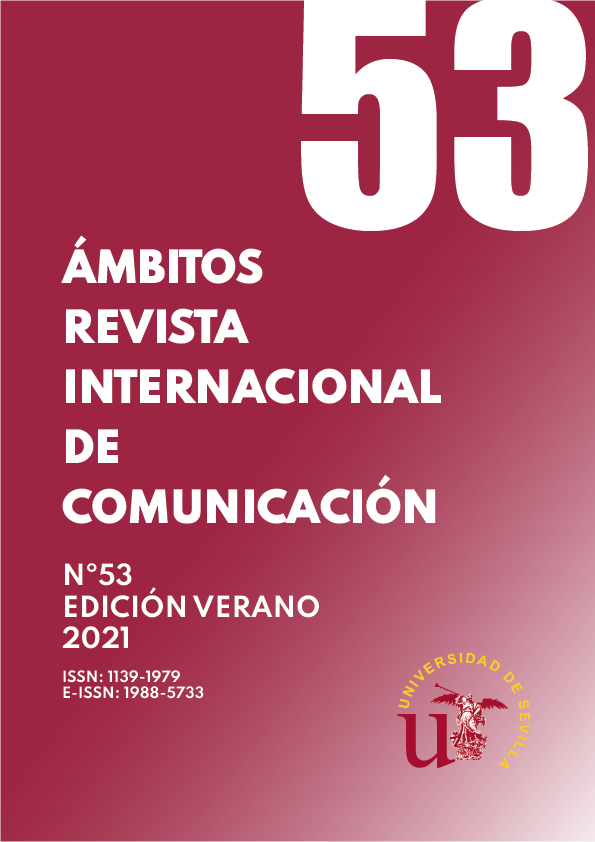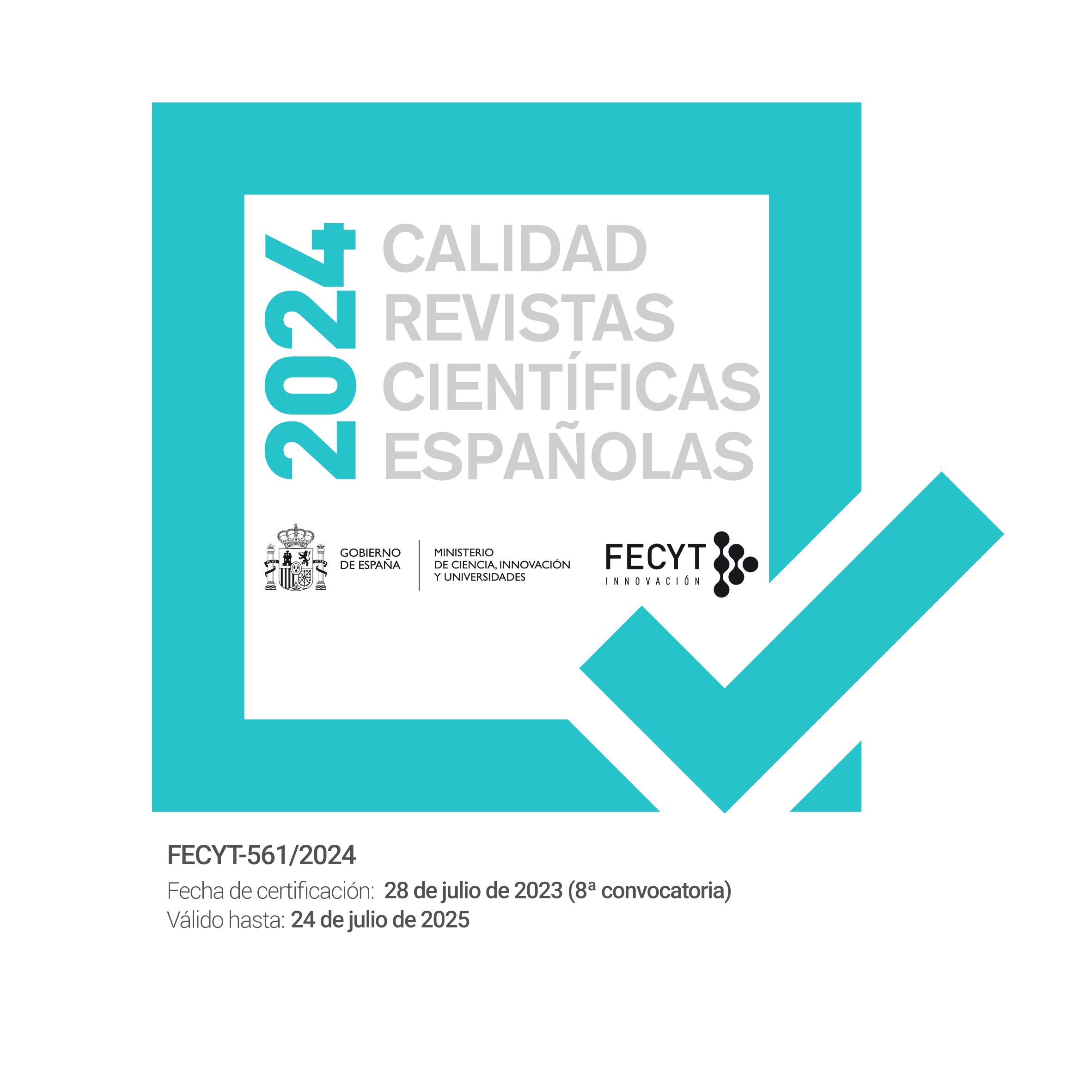Instagram como objeto de estudio en investigaciones recientes. Una revisión de literatura con enfoque en revistas científicas
DOI:
https://doi.org/10.12795/Ambitos.2021.i53.01Palavras-chave:
Instagram, Redes sociales, Revisión teórica, Análisis de contenidoResumo
Una de las redes sociales con mayor crecimiento en la actualidad es Instagram, lo cual resulta significativo porque apenas celebró su décimo aniversario. Es tal la influencia actual y potencial de esta red social, que se ha planteado esta revisión de literatura sobre investigaciones relacionadas con esta red social, publicadas desde 2018 a la fecha por medio de un análisis de contenido temático. Se han incluido también un número limitado de publicaciones anteriores a este año con el propósito de comparar y destacar los datos aportados por las investigaciones más recientes. La investigación ha tomado en cuenta diversas publicaciones realizadas en inglés y español, seleccionadas de diversas revistas científicas indizadas. Los datos permiten establecer conclusiones sobre las principales temáticas tratadas en los últimos años, donde resaltan los análisis de públicos, el marketing, la propaganda, los influencers y un lado oscuro, representado por la ansiedad, depresión y el conflicto. Los datos obtenidos permiten conocer las tendencias más recientes en cuando a la investigación sobre Instagram y a la vez ayudan a vislumbrar hacia dónde se dirigen esta red y sus usuarios.
Downloads
Referências
Ayora, V., Horita F., y Kamienski, C. (2021). Profiling Online Social Network Platforms: Twitter vs. Instagram. Digital Methods, 2792-2801. https://doi.org/10.24251/HICSS.2021.341
Belanche, D., Flavián, M. y Ibáñez-Sánchez, S. (2020). "Followers’ reactions to influencers’ Instagram posts", Spanish Journal of Marketing - ESIC, 24(1) 37-54. https://doi.org/10.1108/SJME-11-2019-0100
Boerman, S.C. (2019). The effects of the standardized instagram disclosure for micro- and meso-influencers. Computers in Human Behavior, 103, 199-207. https://doi.org/10.1016/j.chb.2019.09.015
Casado-Riera, C., y Carbonel, X., (2018). La influencia de la personalidad en el uso de Instagram. Aloma, Revista de Psicologia, Ciències de l’Eduació i de l’Esport 36(2), 23-31. https://doi.org/10.51698/aloma.2018.36.2.23-31
Casaló, L.V., Flavián, C., y Ibáñez-Sánchez, S. (2020). Be creative, my friend! Engaging users on Instagram by promoting positive emotions. Journal of Business Research, (en prensa). https://doi.org/10.1016/j.jbusres.2020.02.014
Carpenter, J.P., Morrison, S.A., Craft, M., Lee, M. (2020). How and why are educators using Instagram? Teaching and Teacher Education, 96 1-14. https://doi.org/10.1016/j.tate.2020.103149
Chavez, A., & Vallejos-Flores, M. (2021). Diseño y validez de la Escala de Adicción a Instagram de Bergen (BIAS) en adultos peruanos. Propósitos y Representaciones, 9(1), 1-15. http://dx.doi.org/10.20511/pyr2021.v9n1.973
De-Sola-Pueyo, J. Nogales-Bocio, A.I. y Segura-Anaya, A. (2021). Nuevas formas de comunicación de la radio: la investidura de Pedro Sánchez 'radiada' en Instagram. Revista Mediterránea de Comunicación, 12(1), 129-141. https://www.doi.org/10.14198/MEDCOM000017
Djafarova, E., Bowes, T. (2021) ‘Instagram made Me buy it’: Generation Z impulse purchases in fashion industry. Journal of Retailing and Consumer Services, 59. https://doi.org/10.1016/j.jretconser.2020.102345
Engeln, R., Loach, R., Imundo, M.N., y Zola, A. (2020). Compared to Facebook, Instagram use causes more appearance comparison and lower body satisfaction in college women, Body Image, 34, 38-45. https://doi.org/10.1016/j.bodyim.2020.04.007
Fondevila-Gascón, J.F., Gutiérrez-Aragón, O., Copeiro, M., Villalba-Palacín, V., Polo-López, M. (2020). Influencia de las historias de Instagram en la atención y emoción según el género. Comunicar Revista Científica de Educomunicación Comunicar, 63(28) 41-50. https://doi.org/10.3916/C63-2020-04
García, V., Berrocal-Gonzalo, S. y D’Adamo, O. (2020). Atributos de liderazgo en Instagram durante las elecciones presidenciales en Argentina 2019. index.comunicación, 10(1), 173-194. https://doi.org/10.33732/ixc/10/01Atribu
Gil-Quintana, J., y Fernández-Galiano, M. (2020) Publicaciones, interacciones, verdades y mentiras de adolescentes españoles en Instagram. Texto Livre Linguagem E Tecnologia, 13(1), 20–44. https://doi.org/10.17851/1983-3652.13.1.20-44
Góngora Díaz, G. y Lavilla Muñoz, D. J. (2020). La importancia de la construcción de marca en Instagram para las empresas periodísticas. En Figuereo Benítez, J. C. (Ed.), Estudios multidisciplinarios en comunicación audiovisual, interactividad y marca en la red (pp. 129). Egregius.
Gon, M. (2020) Local experiences on Instagram: Social media data as source of evidence for experience design. Journal of Destination Marketing & Management, en prensa. https://doi.org/10.1016/j.jdmm.2020.100435
Lindholm J, Carlson T, Högväg J. (2021) See Me, Like Me! Exploring Viewers’ Visual Attention to and Trait Perceptions of Party Leaders on Instagram. The International Journal of Press/Politics. 26(1), 67-187. https://10.1177/1940161220937239
IAB Spain (2019). Estudio Anual de Redes Sociales. https://bit.ly/3550PgF
Kvěchová, K. (2021). An Analysis of Products Communicated on Instagram by the Most followed Czech Influencers. SHS Web of Conferences, 90. https://doi.org/10.1051/shsconf/20219001012
Mattei, M.M. (2015). El divismo en tiempos de #Instagram. CIC. Cuadernos de Información y Comunicación, 20, 95-107. https://www.redalyc.org/articulo.oa?id=935/93542537009
McCosker, A., & Gerrard, Y. (2020). Hashtagging depression on Instagram: Towards a more inclusive mental health research methodology. New Media & Society. 1-21. https://doi.org/10.1177/1461444820921349
Metricool (2019). Estudio de Redes Sociales: cómo se han usado las redes sociales en 2019. https://bit.ly/2QwgvEj
Mora, G. M. L., & Aja Gil, M. (2020). Estudio de la presencia digital en MotoGP: Estudio de caso Jorge Lorenzo en Instagram. Ámbitos. Revista Internacional De Comunicación., (48), 102–122. https://doi.org/10.12795/Ambitos.2020.i48.06
Niknam, F., Samadbeik, M. Fatehi F. et al., COVID-19 on Instagram: A content analysis of selected accounts, Health Policy and Technology, en prensa. https://doi.org/10.1016/j.hlpt.2020.10.016
Palazzo, M., Vollero, A., Vitale, P., y Siano, A. (2020) Urban and rural destinations on Instagram: Exploring the influencers’ role in #sustainabletourism, Land Use Policy, 100. https://doi.org/10.1016/j.landusepol.2020.104915
Parmelee, J.H., y Roman, N. (2020) Insta-echoes: Selective exposure and selective avoidance on Instagram, Telematics and Informatics, 52. https://doi.org/10.1016/j.tele.2020.101432
Plaza-Berríos, D. y Gallardo-Echenique, E. (2021). Amas de casa como storytellers y anunciantes de Instagram. index.comunicación, 11(1), 219-238. https://doi.org/10.33732/ixc/11/01Amasde
Prades, M., Carbonell, X. (2016). Motivaciones sociales y psicológicas para usar Instagram. Communication Papers –Media Literacy & Gender Studies, 5(9), 27-36. https://recercat.cat//handle/2072/267447
Ponnusamy, S., Iranmanesh, M., Foroughi, B., y Sunghyup, S.H. (2020). Drivers and Outcomes of Instagram Addiction: Psychological Well-Being as Moderator, Computers in Human Behavior, 107. https://doi.org/10.1016/j.chb.2020.106294
Rietveld, R., van Dolen, W., Mazloom, M., Worring, M. (2020). What You Feel, Is What You Like Influence of Message Appeals on Customer Engagement on Instagram. Journal of Interactive Marketing, 49, 20-53, https://doi.org/10.1016/j.intmar.2019.06.003.
Ruiz-San-Miguel, F., Ruiz-Gómez, L., y Hinojosa-Becerra, M. (2020) Uso de Instagram como herramienta de debate y aprendizaje. 15th Iberian Conference on Information Systems and Technologies (CISTI) 1-7.
Rozgonjuk, D., Pruunsild, P., Jürimäe, K., Schwarz, R.-J., & Aru, J. (2020). Instagram use frequency is associated with problematic smartphone use, but not with depression and anxiety symptom severity. Mobile Media & Communication, 8(3), 400–418. https://doi.org/10.1177/2050157920910190
Sánchez, R., y Aparicio, P. (2020). Los hijos de instagram. Marketing editorial. Poesía y construcción de nuevos lectores en la era digital. Contextos Educativos. Revista de Educación, 41-53. http://doi.org/10.18172/con.4265
Tarullo y García (2020). Hashtivismo feminista en Instagram: #NiñasNoMadres de @actrices.argentinas. Dígitos Revista de Comunicación Digital, 6 31-54. http://dx.doi.org/10.7203/rd.v1i6.172
Segarra-Saavedra, J., & Hidalgo-Marí, T. (2020). Futbolistas en Instagram: análisis del marketing de influencia realizado por los capitanes de Primera División en España. Ámbitos. Revista Internacional De Comunicación, (48), 34–55. https://doi.org/10.12795/Ambitos.2020.i48.03
Senín-Calderón, C., Perona-Garcelán, S., y Rodríguez-Testal, J. (2020). The dark side of Instagram: Predictor model of dysmorphic concerns. International Journal of Clinical and Health Psychology 20, 253-261. https://doi.org/10.1016/j.ijchp.2020.06.005
Sued, G. (2018). Métodos digitales para el estudio de la fotografía compartida. Una aproximación distante a tres ciudades iberoamericanas en Instagram. Empiria, (40), 15-39. https://doi.org/10.5944/empiria.40.2018.22009
Tafesse, W., y Wood, B.P. (2021) Followers' engagement with instagram influencers: The role of influencers’ content and engagement strategy. Journal of Retailing and Consumer Services, 58. https://doi.org/10.1016/j.jretconser.2020.102303
Vallejos-Flores, M., Copez-Lonzoy, A. y Capa-Luque, W. (2018). ¿Hay alguien en línea?: Validez y fiabilidad de la versión en español de la Bergen Facebook Addiction Scale (BFAS) en universitarios. Salud y drogas, 18(2), 175-184. https://ojs.haaj.org/index.php/haaj/article/view/394
van Driel, L., y Dumitrica, D. (2021). Selling brands while staying “Authentic”: The professionalization of Instagram influencers. Convergence, 27(1), 66–84. https://doi.org/10.1177/1354856520902136
Velar-Lera, M., Herrera-Damas, P. y González-Aldea, P. (2020). Uso de Instagram para la comunicación de las marcas de moda de lujo. Palabra Clave, 23(4), 1-32. https://doi.org/10.5294/pacla.2020.23.4.4
Vizcaino-Verdu y Aguaded, (2018) Análisis de sentimiento en Instagram: polaridad y subjetividad de cuentas infantiles. ZER - Revista de Estudios de Comunicación, 25(48) 213-229. https://doi.org/10.1387/zer.21454
Wallace, E., y Buil, I. (2020). Hiding Instagram Likes: Effects on negative affect and loneliness. Personality and Individual Differences, 170. https://doi.org/10.1016/j.paid.2020.110509
Wai, T., Ching, A., Chiu, D. (2020) From Facebook to Instagram: Exploring user engagement in an academic library, The Journal of Academic Librarianship, 46, (6). https://doi.org/10.1016/j.acalib.2020.102229
Downloads
Publicado
Como Citar
Edição
Seção
Licença
Copyright (c) 2021 Juan C. Figuereo-Benítez, Fidel González-Quiñones, Juan D. Machin-Mastromatteo

Este trabalho está licenciado sob uma licença Creative Commons Attribution-NonCommercial-ShareAlike 4.0 International License.
Ámbitos. Revista Internacional de Comunicación é um jornal de acesso aberto, o que significa que todo o conteúdo está disponível gratuitamente para o usuário ou sua instituição. Os usuários podem ler, baixar, copiar, distribuir, distribuir, imprimir, pesquisar ou vincular ao texto completo dos artigos, ou utilizá-los para qualquer outra finalidade lícita, sem solicitar permissão prévia da editora ou do autor. Esta definição de acesso aberto está de acordo com a Iniciativa de Acesso Aberto de Budapeste (BOAI).

A menos que seja observado o contrário, todo o conteúdo da edição eletrônica é distribuído sob uma "Licença Internacional Creative Commons Attribution-NonCommercial-ShareAlike 4.0". Você pode consultar a versão informativa e o texto legal da licença aqui. Isto deve ser expressamente declarado desta forma, quando necessário.
No caso de aceitação do manuscrito, os autores cedem os direitos da obra para sua publicação à Ámbitos. Revista Internacional de Comunicación sob o contrato de licença Attribution-NonCommercial-ShareAlike 4.0 International (CC BY-NC-SA 4.0). Os autores retêm os direitos autorais e terceiros estão autorizados a copiar, distribuir e fazer uso da obra, desde que cumpram os termos e condições estabelecidos na licença
- Cite a autoria e a fonte original de publicação (revista, editora e URL da obra).
- Não utilizá-los para fins comerciais.
- Se você remixar, transformar ou criar a partir do material, você deve liberar suas contribuições sob a mesma licença que o original.
Mais informações podem ser encontradas em
https://creativecommons.org/licenses/by-nc-sa/4.0/deed.es


















